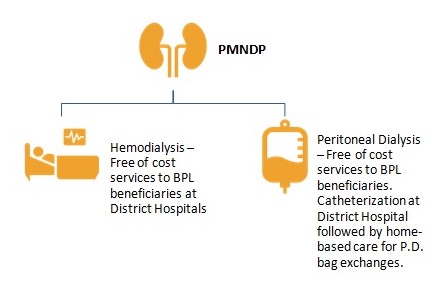ForumIAS announcing GS Foundation Program for UPSC CSE 2025-26 from 27th May. Click Here for more information.
Source: The post is based on the article “Pradhan Mantri National Dialysis Programme” published in PIB on 3rd February 2023
What is the News?
The Union Minister of State for Health and Family Welfare has informed Lok Sabha about Pradhan Mantri National Dialysis Programme(PMNDP).
What is Dialysis?
Dialysis is a procedure that removes waste and fluids from the body that the kidneys are not able to remove.
Dialysis also aims to keep the body in balance by correcting the levels of various toxic substances in the blood.
Without dialysis, all patients with complete kidney failure would die from the build-up of toxins in the bloodstream.
Types of Dialysis: There are two main types of dialysis:
Hemodialysis (HD, commonly known as blood dialysis): In HD, the blood is filtered through a machine that acts like an artificial kidney and is returned back into the body. HD needs to be performed in a designated dialysis center. It is usually needed about 3 times per week, with each episode taking about 3-4 hours.
Peritoneal dialysis (PD, commonly known as water dialysis): In PD, the blood is cleaned without being removed from the body. The abdomen sac (lining) acts as a natural filter. A solution (mainly made up of salts and sugars) is injected into the abdomen that encourages filtration such that the waste is transferred from the blood to the solution.
– There are 2 types of PD – continuous ambulatory peritoneal dialysis (CAPD) and automated peritoneal dialysis(APD). CAPD needs to be done 3 to 5 times every day, but does not require a machine. APD uses an automated cycler machine to perform 3 to 5 exchanges during the night while the patient is asleep.
What is Pradhan Mantri National Dialysis Programme(PMNDP)?

Launched in: 2016-17
Nodal Ministry: Ministry of Health and Family Welfare
Nodal Mission: National Health Mission(NHM)
Aim: To ensure the availability of dialysis services free of cost to Below Poverty Line(BPL) beneficiaries at the district hospitals in the country.
The guidelines for Programme envisage the provision of dialysis services in PPP (Public Private Partnership) mode.
Financing: For Below Poverty Line (BPL) economic group: 100% expenses are directly covered under NHM by the government.
For non-BPL patients: They can get treated at the district hospitals by paying the same rates as paid by the government for the BPL patient.




